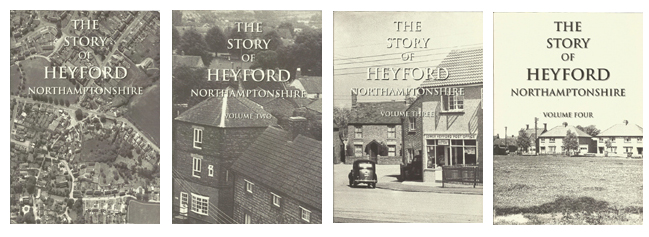At about 11.20 am on the 21st September 1951, the 8.20 am Liverpool Express to London came off the track at the Stowe Hill Tunnel near Heyford and tipped over in the embankment. The crash killed eight people and another seven died later in hospital. There were also thirty-six other casualties.
David Blagrove, in his book, “Waterways of Northampton” describes how “the railway can be seen plunging into Stowe Hill Tunnel” and it was here that the train, “hauled by the Duchess class Pacific engine, Princess Arthur of Connaught, left the rails shortly after leaving the tunnel at a speed of between sixty and sixty-five miles an hour.”
Engine 46207 Princess Arthur of Connaught

Photo taken by James Banner and lent by Ted Garrett
A prompt response
Frank Denny, the Heyford signal man that day, was the first to realise what happened. His signal box was located about a quarter of a mile from the railway bridge in Furnace Lane, along the stretch of line between Heyford and Bugbrooke. As the signalman, Frank was aware that the train had entered the tunnel from Weedon but he became anxious when it did not reappear. As he looked out of his box, he saw steam rising from the embankment near Tanborough Farm.
Frank instinctively knew something was wrong and realised that his first priority was to halt the Royal Scot which was travelling from London and due to pass at any moment. He therefore rang through to the Banbury Lane signal box at Bugbrooke to get the signal switched to stop. This duly happened the Royal Scot came to a halt near his own box. The driver got out to demand “what the hell is going on.” It was due to Frank’s swift response that a much more serious accident was averted.
MBE
At the same time, Mrs Cecily Hughes, the doctor’s wife at Weedon, took a call from the Weedon Stationmaster to say that the Liverpool Express had failed to clear his section of the line. He asked if she and her husband, Dr Stephen Hughes, would take a look. So far, that was all that anyone knew.
The couple set off in their car, armed with first aid that they always carried. They arrived at the tunnel within seven minutes of the accident. Mrs Hughes describes how they found nothing at the tunnel entrance so they climbed up over the hill – to be greeted by the sight of the crash strewn along the line.
The rescue operation

Photo taken by James Banner and lent by Ted Garrett
The first four coaches were the most damaged and contained the dead and badly injured. The doctor took one side of the train and his wife the other, clearing the debris in order to reach casualties. Mrs Hughes recalls how “Everyone was calm and patient. The last two carriages had not even left the rails and were still upright. They were full of boys returning to boarding school and one of the senior boys took charge, leading the others away from the scene and back to Weedon, to the Globe Inn.”
The doctors found the engine driver, Mr Tomlin, buried up to his shoulders in coal from the tender. It took a while to dig him out but he was quite unhurt, as was the train’s fireman who had clung to the cab as the engine tipped over.
After attending to all the serious casualties, Dr and Mrs Hughes returned to Weedon, only to find that many more people, including some of the rescuers, were waiting for treatment for minor cuts and bruises.
As some of the first medics on the scene, the contribution made by the Hughes’s was invaluable. Mrs Hughes was later awarded the MBE for her part in the rescue operation. She was reluctant to accept at first, as there were also others who had helped at the crash site and she felt that she was only doing her job. However, Mrs Hughes was described as “heroine of the morning” and duly received her medal.
Witnesses
Several Witness also came forward including a bus driver on the A5 who saw the immediate aftermath of the accident and reported it at Weedon station. It was also very fortunate that a police car happened to be passing the scene along Watling Street as it was one of only two police cars fitted with a radio in the entire county. They were able to summon medical help promptly.
Mr George Richardson of London Was driving along the A5 at the time and said: “I saw the train come out of the tunnel and begin to wobble.”
This “wobbling” and lurching was felt by passengers too. One survivor, Mr Blankfield of Liverpool, explained, “I was in a carriage half-way along the train . . . there were four or five jolts and then the train stopped completely.” He described how he and other passengers immediately climbed out of the windows to help others further along the train.
The damage
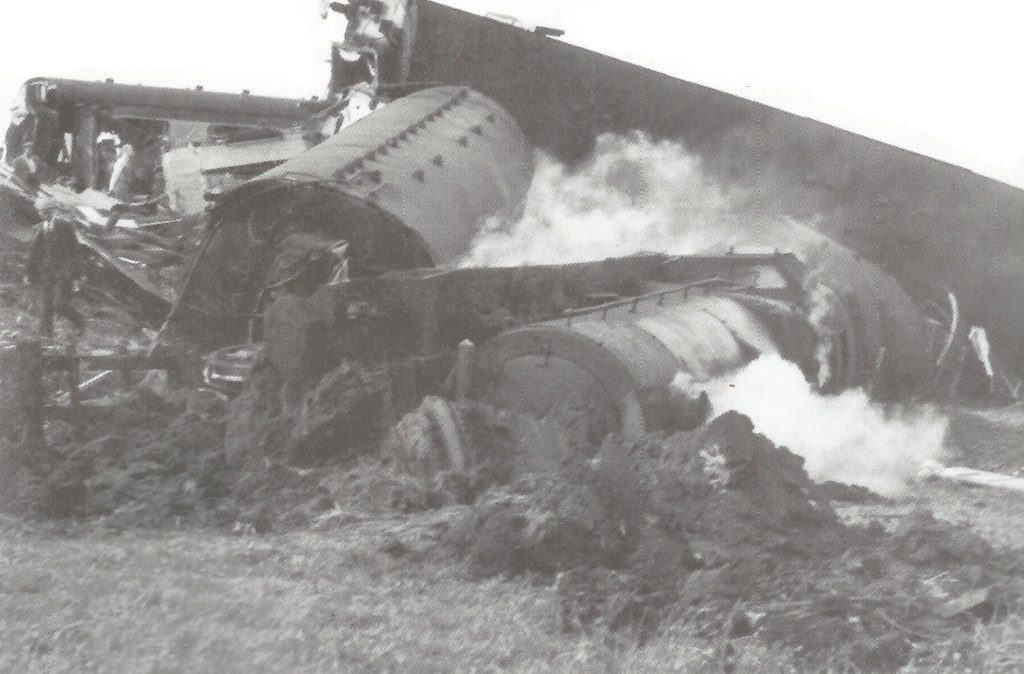
Photo taken by James Banner and lent by Ted Garrett
Local help
For local people in Heyford who worked near the railway, the sound of trains was a familiar one and you could tell exactly the time of day by the individual noise of each train that passed. When the crash occurred, Mr Gray of Tanborough Farm apparently thought that his wife had knocked over the dresser. But after that, apart from the hissing of the engine, there was an eerie silence.
Word quickly got around and people went up to help. Amongst the first on the scene were Reg and Joan Collins of Wharf Farm. They provided milk churns so that water could be carried up the hill to the casualties. There was no shortage of volunteers to take the churns but at the end of the day. Reg. had to go round and collect them all back again in his tractor and trailer in time for the evening milking.
Joan had to cycle down to Mrs Blaney at the Post Office with messages to be telegrammed to relatives. At this time, there was only the one phone with one public line out of the village. The officials did their telephoning from Holly Lodge which had one of the few phones in Heyford.
Ted Garrett was booking clerk at Weedon Station that day. When the crash happened, communications between Weedon and Heyford were suddenly lost, so they knew that something was amiss. In fact, as the train was thrown from the track, it had brought down the telegraph poles and cut all contact. A message finally arrived at Weedon via Roade Station that there had indeed been a crash. Ted Garrett was given charge to inform the army located at Weedon Depot and ask them to help at the crash site.
Frank Smith arrived with the Daventry ambulance and took the first casualties to Northampton General. He was actually on his second trip to the hospital by the time other ambulances appeared. Then the army from Weedon arrived to help. As they appeared over the hill, people recalled that it looked as though they were on manoeuvres.
Retired district nurse, Miss Raynor – over 70 years of age – walked two miles from Weedon to the crash site with a case of medical supplies. The Salvation Army and the W.V.S. set up mobile canteens and were there all day. The women from the Heyford railway cottages brought up hot tea for the survivors and people also brought blankets and sheets. The sheets were torn up to make bandages and the blankets kept the survivors warm. These were, of course, not returned but compensation was later given to those who had provided them.
The curse of the tunnel
The crash was reported in the national media and was news on the BBC Home Service. Local papers were full of the story; Northampton’s Chronicle and Echo carried the banner headline “8 KILLED IN WEEDON TRAIN CRASH” although this figure was unfortunately to rise. The Daventry paper went further and wondered if there was a more sinister aspect to Stowe Hill Tunnel. The paper reported that at the same spot in 1915 there had been another fatal train crash.
There were similarities between the two railway accidents. Both occurred about the same time of year with trains that had left at the same time in the morning. On 14th August 1915, the Irish Mail left Euston at 8.30 am and it too was disrailed; this time as it left the tunnel at the Weedon end heading north. The crash killed nine and injured 13 and many of those on board were troops in service during World War One.
However, despite the comparisons, the crash of 1915 was caused by a broken coupling left by a passing train. The coupling had ploughed into the track and so dislodged the oncoming mail train.
Board of Trade
In both crashes, the stretch of line was not found to be at fault. In 1951, the investigation by the Board of Trade was led by Lieutenant-Colonel G.R.S. Wilson. He concluded that the engine (number 46207 for train buffs) had an axle incorrectly fitted after its servicing at Crewe. The axle was slightly too tight, enough to cause a problem when it reached Stowe Hill Tunnel. There is a small change in rail type leading in and out of the tunnel (from flat bottom to bull head track) and, with the axle too tight, the Express dislodged when it went over these rails. The service engineer responsible at Crewe was named but, this being the 50’s and not the 90’s, there was no huge compensation claim or court case.
The engine itself had embedded in the soft clay around Stowe Hill and actually suffered little damage. However, it took almost a month before it could be lifted because of the steep ditch of the embankment. The engine had to be lifted out by a crane and villagers can remember its massive size as it was hauled into the air. It was then towed back to Crewe and was running again within six weeks. Driver Tomlin actually drove the Liverpool Express one more time to London, but never again after that.
By Sarah Croutear. A number of people have contributed to this story but we must give particular thanks to Joan Collins, Ted Garrett, Cecily Hughes and Doris Lovell, Frank Denny’s daughter.
~~
Added 2020:

British Pathe News
British Movietone News
The Illustrated London News
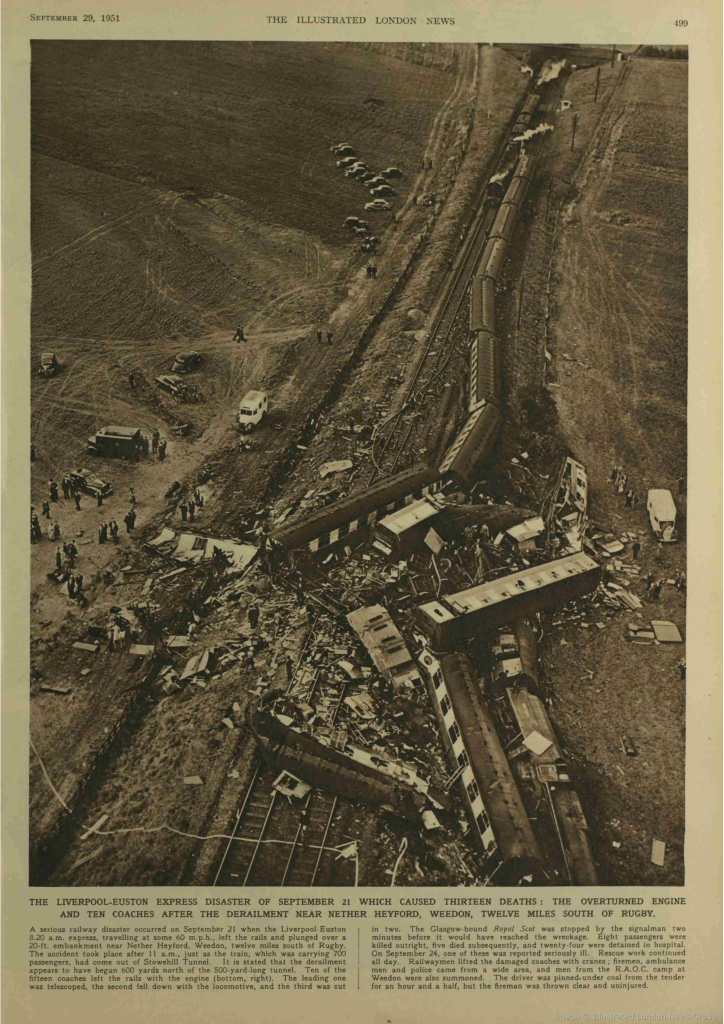
Britain From Above
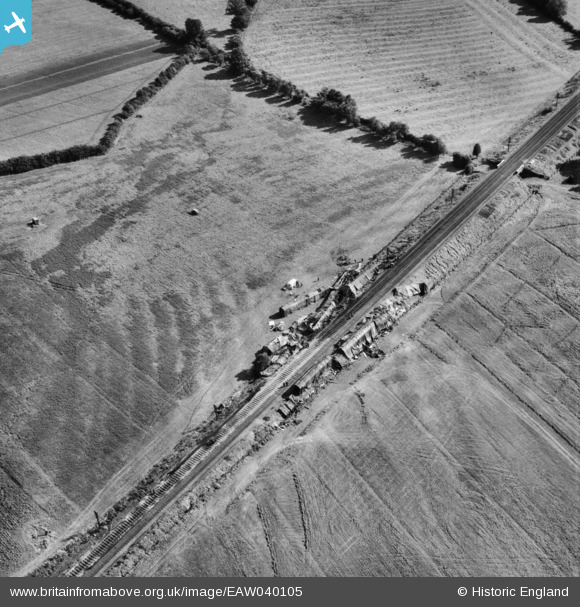
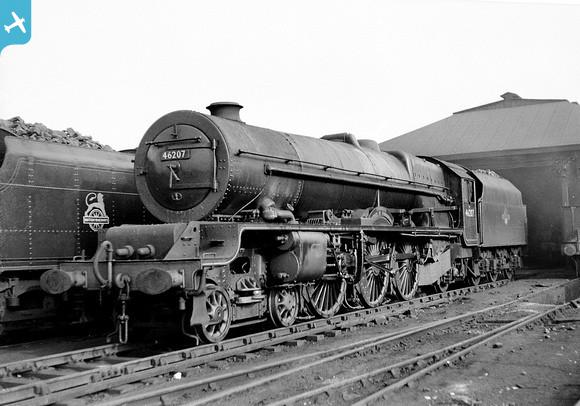

https://www.britainfromabove.org.uk/en/image/EAW040105
No. 6207, A Study in Steel (1935) LMS
Ministry of Transport Crash Report
Report on the Derailment which occurred on 21st September 1951 near Weedon in the London Midland Region British Railways
“The 8.20 a.m. Up express passenger train from Liverpool to Euston, comprising 15 bogie coaches hauled by a Pacific type engine, was travelling at 60-65 m.p.h. on the leaving transition of a left handed curve of about 50 chains radius, when the leading bogie wheels of the engine were derailed to the right ; the cause was an engine defect. The derailment was not noticed by the enginemen at this stage and the train continued forward at speed for more than £¾ mile on the straight without serious damage to the flat bottom track. No more wheels were derailed until the train reached the bull head rails just beyond the short Stowe Hill tunnel, when the leading bogie wheels began to smash the chairs and break up the track with the result that the whole of the train left the rails except for the last two vehicles.
The engine went down the 12 ft. embankment to the left, and fell on its left hand side: on soft ground. The wreckage of the coaches at the front of the train was severe, and I regret to state that seven passengers and one of the dining car staff were killed outright and seven passengers died subsequently in hospital. In addition, 26 passengers, the engine driver, and nine members of the dining car staff were admitted to hospital, or 36 persons in all, of whom 15 were discharged on the same day, and 25 others sustained minor injuries or shock. The driver, who was on the left hand side of the footplate, had a fortunate escape from serious injury when he was buried in coal from the tender as the engine overturned ; the fireman clung to the right hand side of the cab and was unhurt.
The wreckage of the eight leading coaches was piled behind and alongside the overturned engine across both the tracks. It was seen by the signalman at Heyford box 950 yards ahead when he heard the noise of the final derailment, and he stopped the approaching Down “Royal Scot” express at his outer home signal at 11.19 am., and afterwards drew it forward to the box. The block and telephone wires northward were severed, but the signalman got a message through to the Control via Blisworth, the next junction box to the south. Medical and other assistance was also summoned from all possible sources by some officers of the Metropolitan Police who had seen the wreckage from their car on the neighbouring main road. The Northamptonshire County Police were quickly on the scene and performed outstanding services in co-ordinating the work of rescue.”
Magazine Article


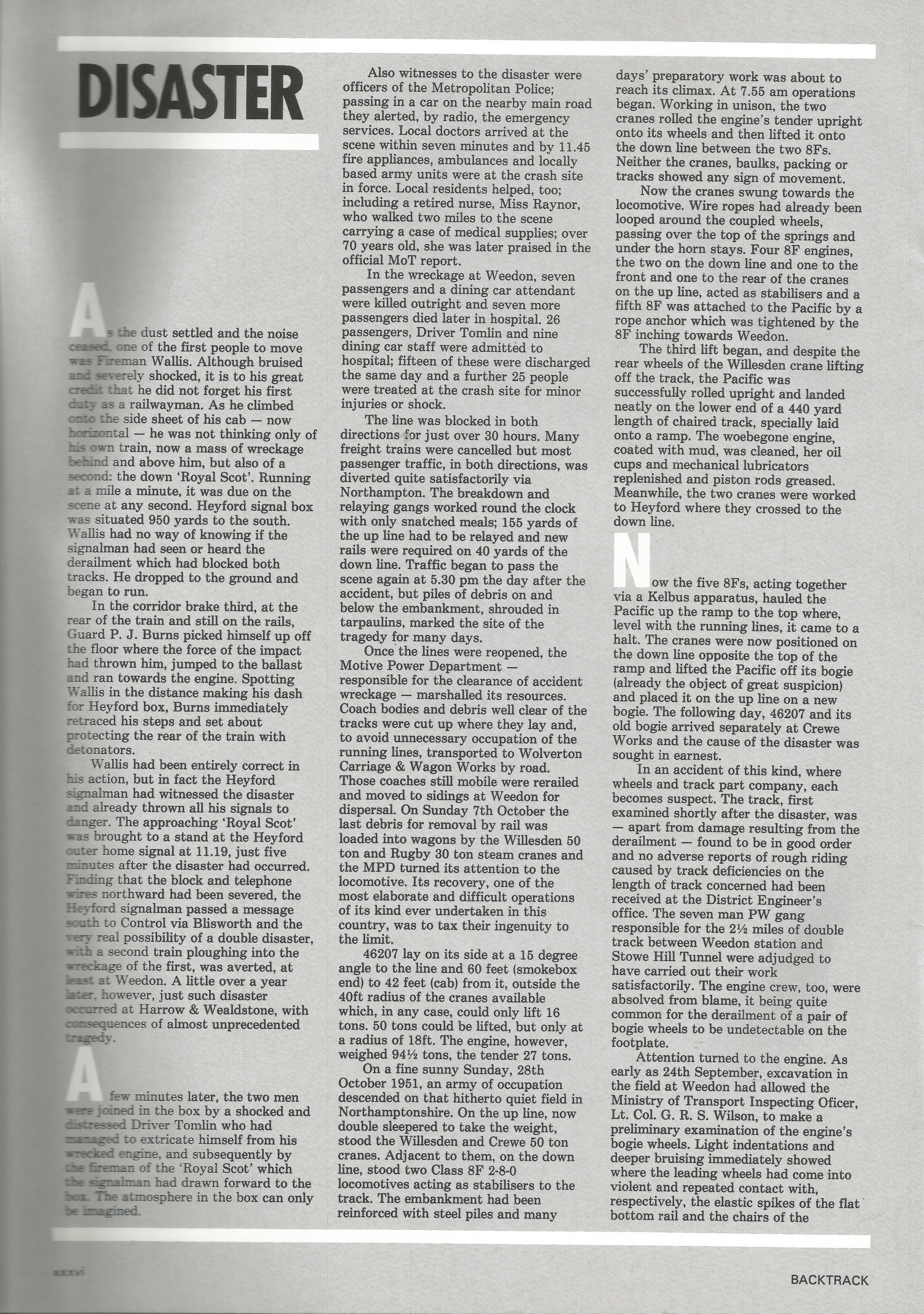

Jez Wilson – Updates added September 2021
~~
Extract from “The Story of Heyford” – Local book series published in the late 1990’s
Volume 3 of 4 | Chapter 3 of 17 | Page 4 to 7

